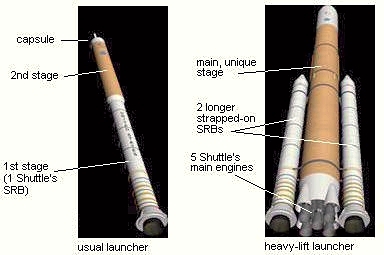
 NASA's Next-Generation Crew and Exploration System. The Space Shuttle is going to be retired by 2010, leaving NASA with the need of a new crew vehicle. The "Crew Exploration Vehicle" (CEV) will be this vehicle. It will have the daunting task to serve, at the same time, like the ferrying vehicle for crew and cargo at destination of the International Space Station (ISS), the vehicle which will be able to take a crew of four to the Moon, and the vehicle which will allow a crew of six to journey to Mars. The CEV proper will just look like an Apollo era capsule, three times larger however, and reusable up to 10 times. The next-generation vehicle comes with a new launch ensemble. The new launch system however mainly relies on Shuttle's Solid Rocket Boosters (SRBs) and main engine. The new launch vehicle comes in two types. A first one is made of a Shuttle's SRB like the first stage, with a second stage propelled by a Shuttle's main engine (left). A second one will be used for heavy-lift tasks and Moon missions, using five Shuttle's main engines on a main, one-stage body, and two longer, strapped-on SRBs (right). The CEV system will first be used to complete the International Space Station (ISS), then to be back on Moon (2018) and, from there, to journey to Mars. The missions to the Moon will borrow their concepts to the Apollo program as their main objective will be the set up of a permanent station on our satellite. picture site 'Amateur Astronomy' based on a picture NASA
NASA's Next-Generation Crew and Exploration System. The Space Shuttle is going to be retired by 2010, leaving NASA with the need of a new crew vehicle. The "Crew Exploration Vehicle" (CEV) will be this vehicle. It will have the daunting task to serve, at the same time, like the ferrying vehicle for crew and cargo at destination of the International Space Station (ISS), the vehicle which will be able to take a crew of four to the Moon, and the vehicle which will allow a crew of six to journey to Mars. The CEV proper will just look like an Apollo era capsule, three times larger however, and reusable up to 10 times. The next-generation vehicle comes with a new launch ensemble. The new launch system however mainly relies on Shuttle's Solid Rocket Boosters (SRBs) and main engine. The new launch vehicle comes in two types. A first one is made of a Shuttle's SRB like the first stage, with a second stage propelled by a Shuttle's main engine (left). A second one will be used for heavy-lift tasks and Moon missions, using five Shuttle's main engines on a main, one-stage body, and two longer, strapped-on SRBs (right). The CEV system will first be used to complete the International Space Station (ISS), then to be back on Moon (2018) and, from there, to journey to Mars. The missions to the Moon will borrow their concepts to the Apollo program as their main objective will be the set up of a permanent station on our satellite. picture site 'Amateur Astronomy' based on a picture NASA
Website Manager: G. Guichard, site 'Amateur Astronomy,' http://stars5.6te.net. Page Editor: G. Guichard. last edited: 12/28/2010. contact us at ggwebsites@outlook.com

